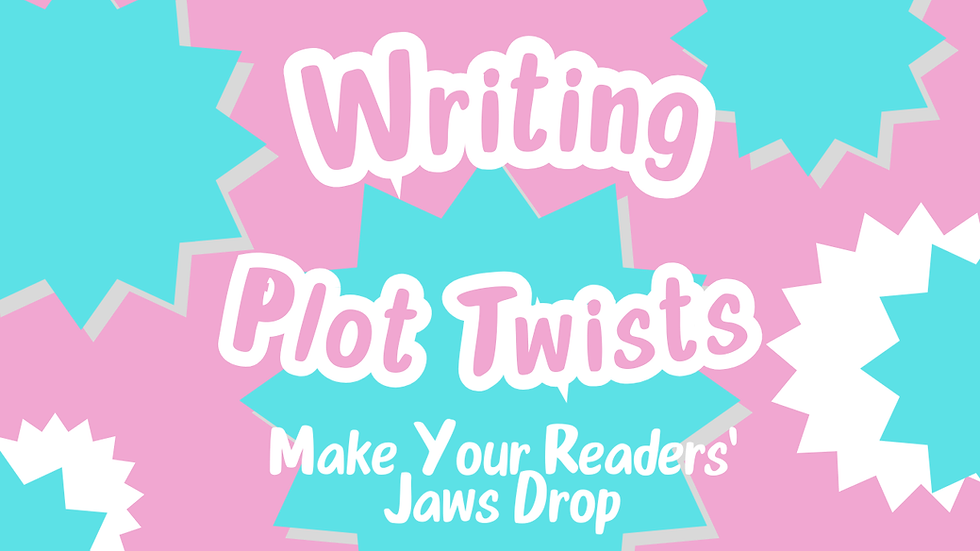How to Craft Jaw-Dropping Plot Twists that Leave Readers Begging for More!
- Eva L. Roy
- Apr 9
- 4 min read

Plot twists have the power to transform a straightforward narrative into an unforgettable experience, driving your readers into a world filled with surprises and excitement. A well-crafted twist can leave them gasping or reflecting long after they have finished reading. But how do you create these jaw-dropping moments that both shock and resonate? Let's dive into the art of crafting compelling plot twists!
Understanding the Role of Plot Twists
Plot twists are essential in many captivating stories. They challenge readers' expectations while adding complexity to a narrative. A well-executed twist balances surprise with believability and transitions the story into a new direction. If you know me, you know I LOVE the Three Act Story Structure and according to this method, the Plot Twist has to shift the main character's goal. Something unexpected is going to upend the protagonist's original plan, and now they need to create a new one.
Building a Strong Foundation
Before weaving in a twist, lay a strong foundation for your story. Ensure your characters are well-developed and relatable by developing their internal conflict. When readers connect emotionally with your characters, any twist will have a more significant impact.
The Art of Foreshadowing
Foreshadowing is a critical technique for creating effective plot twists. By providing subtle hints throughout your narrative, you prepare readers for the twist without revealing it outright. For instance, if a side character casually mentions their dislike for a certain place, it might later reveal a hidden connection or motive that will stand in the way of the protagonist's plan later on.
However, effective foreshadowing requires a delicate balance. Too many obvious clues might spoil the surprise, while too few can leave readers feeling cheated. Aim for intriguing but subtle hints. This is your chance to create that AHA! moment for the readers when later on, they realize there were clues leading to the plot twist the whole time.
Misleading Expectations
One of the most thrilling aspects of plot twists is the element of surprise. Misdirection can be a clever way to achieve this. By leading readers down a familiar path and making them think they’ve figured out the outcome, you can pull the rug out from under them with a dramatic turn.
For example, in "Harry Potter and the Prisoner of Azkaban", Harry, Ron, and Hermione are led to believe that Sirius Black is a dangerous criminal who betrayed Harry's parents and is intent on harming Harry throughout the book. The narrative builds tension around this premise, leading readers to anticipate a confrontation between Harry and Sirius, reinforcing the idea that Sirius is the villain.
Plot Twist
However, in a dramatic turn of events, it is revealed that Sirius is actually Harry's godfather and has been wrongfully imprisoned for crimes he did not commit. The true traitor is revealed to be Peter Pettigrew, who has been living in disguise as Ron's pet rat, Scabbers. This twist not only redefines Sirius's character but also shifts the entire perspective of the story, showcasing the clever use of misdirection.
Impact
This revelation surprises both the characters and the readers, effectively pulling the rug out from under them and transforming the narrative into one of loyalty, friendship, and the quest for justice. The clever misdirection keeps the audience engaged and invested in the characters' journeys, making the twist all the more impactful.
Develop Multi-Dimensional Characters
Characters that are multi-dimensional with conflicting motives can enhance the effectiveness of your twists. Readers are more likely to be shocked when unexpected actions align with a character's established complexity.
When creating characters, ensure they have unique traits, backgrounds, and desires. An example is Severus Snape from “Harry Potter.” His character is layered with complexity that makes his eventual reveal of loyalty super surprising. A twist involving a character’s betrayal or hidden identity will resonate deeply when readers see them as subtle individuals.
Creating Conflict and Tension
Tension is the heartbeat of any gripping story. It keeps readers invested and eager to learn how situations will unfold. Introduce conflicts that challenge your characters, setting the stage for potential twists. Build up to your twist with heightened stakes and imminent danger.
Timing and Pacing
The timing of a plot twist can make or break its impact. Dropping a twist too early can lessen its effectiveness, while revealing it too late might frustrate readers.
Pacing is equally important. Allow for a buildup that leaves readers craving resolution before delivering the reveal. Think of anticipation as a pressure cooker; allowing tension to build makes the release all the more satisfying.
Summary
Crafting jaw-dropping plot twists can be a thrilling challenge. When executed well, these twists can elevate storytelling to new heights. Through careful planning, strong character development, and smart use of foreshadowing and timing, you can keep your readers guessing until the very last moment. The combination of a stunning twist and a satisfying resolution will have readers eagerly awaiting your next story.
So, embrace your creativity and let your imagination guide you through the twists and turns of your narrative. Your readers will appreciate the unforgettable journey you create!






Comments